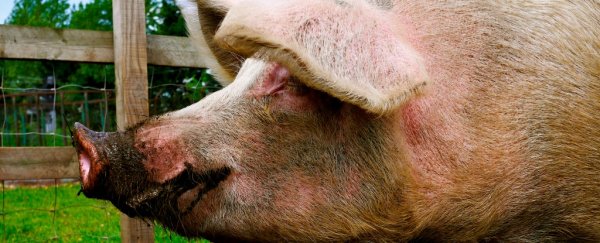For years, forensic experts have been studying dead pigs to try and understand how human bodies decompose in different environmental and weather conditions, and to figure out how long a person has been deceased.
But new research suggests that these human stand-ins are just not good enough when it comes to figuring out the time of death for a human being. For that, you need to study actual dead humans, and that's a problem (for obvious reasons).
If the results of this study are replicated, it's a pretty big deal, because data taken from decomposing pigs has been heralded in the past as an accurate way for forensic investigators to pinpoint the timeline in murder trials. The new findings suggest that this isn't the case, which means the research shouldn't be used in court.
The study, conducted by researchers from the University of Tennessee's Forensic Anthropology Centre – better known as the Body Farm – examined how 15 pigs, rabbits, and humans decomposed in the same environment. To pull this off, the team broke the experiment into three trials, leaving five of each type of corpse outside during winter, summer, and spring.
In the end, they found that all of the test subjects decomposed a vastly different rates - with pigs decomposing faster than humans on average - and that the human body varied more wildly from body to body than the rabbits or pigs did. Specific body decay times weren't released, but the information lead the researchers to conclude that pigs - or any other animals - cannot be used to accurately predict a time of death in a human.
"What we're saying is that to estimate the time since death for human forensic cases, our results indicate that human subjects are best, because the pigs and the rabbits do not capture the variation we saw in the humans," the Body Farm's director, Dawnie Wolfe Steadman, told Erica Goode at The New York Times.
Though pigs might not be fit to accurately describe how humans decompose, they're still valuable to forensic researchers, because they allow them to study which types of insects and scavengers flock to decomposing flesh in different regions, Goode reports.
Besides the main findings of the study, the team was also struck by how differently the human bodies decomposed compared to one another. They found that bodies of those who were on chemotherapy drugs decomposed differently than those that weren't. In short, everyone's a bit different.
"All of us have various diets, our body composition varies widely, and it's not just weight," Steadman told The New York Times. "Individuals who have a lot of fat decompose faster than lean individuals."
Forensics isn't the only field currently getting help from dead pigs. A team of Canadian researchers recently performed an experiment to see how pigs decomposed underwater to give rescue divers a better idea of what they should be searching for.
As Jacinta Bowler reported for us back in March: "[T]he study is important, because knowing what state a submerged body is in is crucial for rescue divers – depending on the number of days someone's been missing, they might be looking for an intact body, or a pile of bones."
While pigs have long been a human stand-in because, you know, dead bodies aren't easy to come by, that's all starting to change, thanks to the rise of body farms: large outdoor 'farms' that researchers fill with human corpses to study how they decompose, attract insects and other things.
These first started to pop up back in 1987, when William M. Bass discovered that forensic anthropologists had little idea what to actually look for at a crime scene. And as you can see in the video tour below (warning: graphic), it's a gross job, but someone's gotta do it.
The team findings were presented earlier this year at the annual American Academy of Forensic Sciences conference, and haven't been published in a peer-reviewed journal just yet, so we need to take them with a grain of salt until they can be further studied and replicated.
But, in future, CSI might need to get some new forensic tricks.

